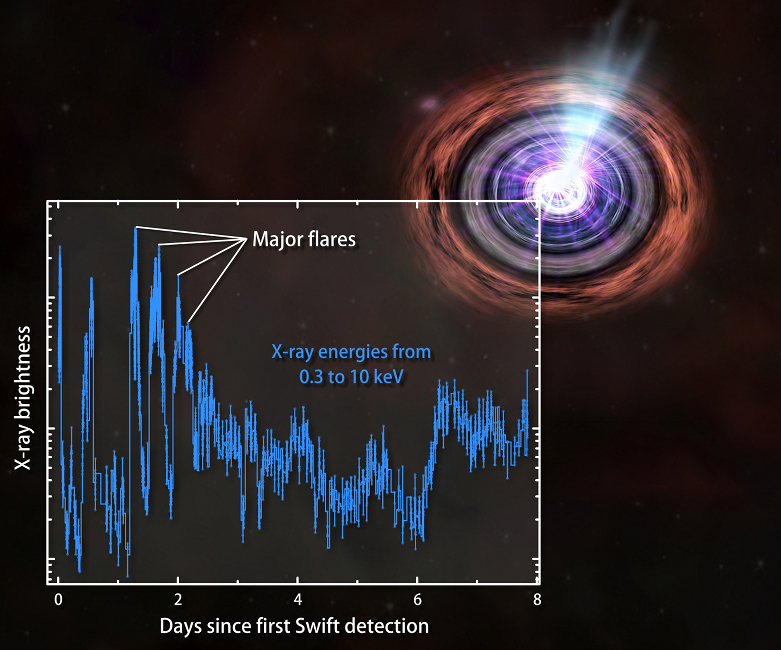
 Credit: NASA/Swift/Penn State/J. Kennea
Credit: NASA/Swift/Penn State/J. Kennea
Down the Rabbit Hole
It's a dangerous Universe we live in, so watch where you're going. If you don't you might step in a hole, and be gone for good. Astronomers think such a fate actually befell a star in an otherwise non-descript galaxy about 3.8 billion light-years from us, lying in the constellation of Draco. Information about this tragic event, which occurred about 3.8 billion years ago, only arrived on our cosmic doorstep this past March 28, when the Burst Alert Telescope on the Swift satellite detected a series powerful X-ray bursts. A followup image of the burst, now called GRB 110328A, by the Hubble Space Telescope identified the galaxy in which the burst occurred, while a deep image using the Chandra X-ray Telescope showed that the burst, still bright in X-rays, lay dead center in the middle of the galaxy. This is a rather unusual position for such a burst, since most of them lie somewhat outside the galactic center. The burst was also unsually long - the source has repeatedly flared (as shown in the image above), and since April 3, for example, it has brightened by more than five times. Other similar burst sources are produced by the explosion of a massive star and the formation of a black hole, but these powerful events usually don't last very long. The unusual duration of GRB110328A, and its location near the center of a galaxy, suggests that it was produced by a star which wandered too close to a supermassive black hole at the center of the galaxy. The strong gravity of the supermassive black hole would tear the star apart, and the broken up lumps of stellar matter would cause the high energy emission from the black hole to brighten for quite awhile before the material disappears behind the curtain of the event horizon. What wonderland lies on the other side? Hopefully we never find out. Maybe it's always tea-time.
Published: April 11, 2011
<
HEA Dictionary ● Archive
● Search HEAPOW
● Other Languages
● HEAPOW on Facebook
● Download all Images
● Education ● HEAD
>

Each week the HEASARC
brings you new, exciting and beautiful images from X-ray and Gamma ray
astronomy. Check back each week and be sure to check out the HEAPOW archive!
Page Author: Dr. Michael F. Corcoran
Last modified Tuesday, 27-Feb-2024 10:15:15 EST


